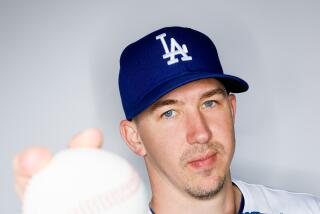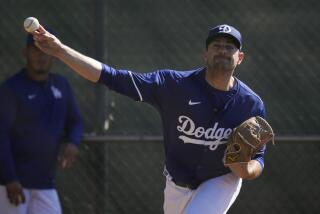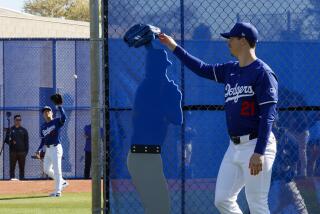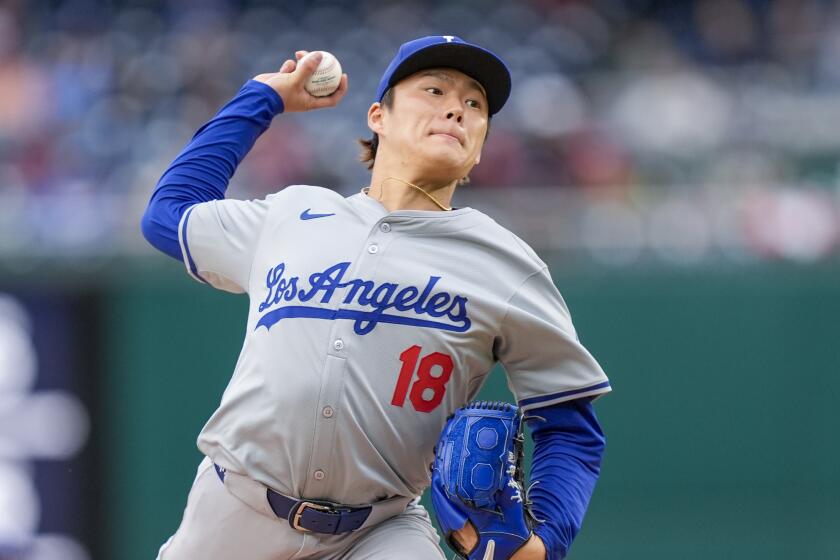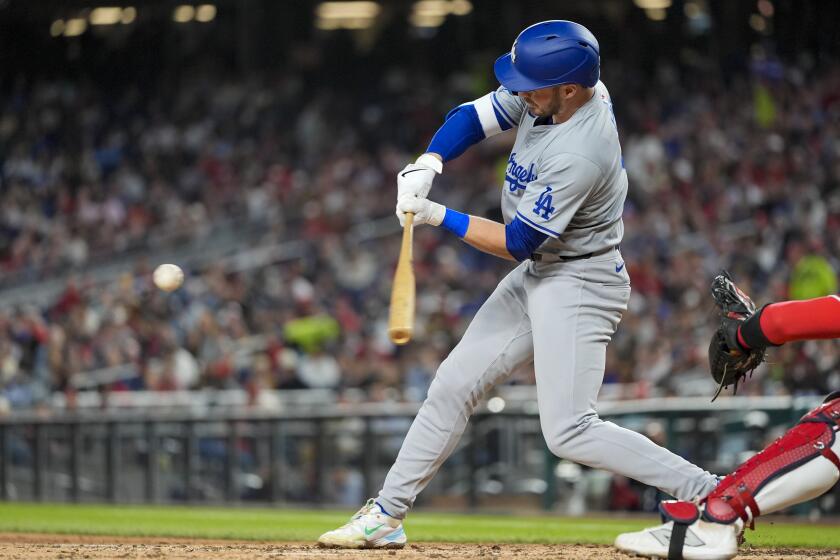Injuries take time to heal — the Dodgers just won’t say how long
Tom Koehler sounded apologetic. Nearly a month had passed since Koehler, a pitcher the Dodgers signed this winter in hopes of replacing set-up reliever Brandon Morrow, suffered a shoulder strain. The expected date of his return remained a mystery to the public. This was by design.
“Right now, I would say I comfortably have a date in my head,” Koehler said earlier this week during the Freeway Series at Dodger Stadium. “But I think the reason they don’t want to get it out there, maybe they don’t want to give me that firm date, because if we do take a day or two off, then that pushes things back. That just protects from unnecessary questions.”
As the Dodgers prepare to open the 2018 season on Thursday against San Francisco, aiming to defend their National League pennant and capture the championship which has eluded this franchise since 1988, so much about this club feels assured.
Clayton Kershaw will disarm hitters with sliders and curveballs, while Kenley Jansen will close games with cutters. Corey Seager and Cody Bellinger will launch baseballs into orbit. A huge ovation awaits Matt Kemp as he suits up in Dodger blue for the first time since 2014. The number of scatalogical jokes about the ballpark’s burst water pipe on Tuesday will overflow.
And over the course of the 162-game season, the Dodgers will sound quite vague about injuries.
During spring training at Camelback Ranch in Arizona, the Dodgers experienced only two major calamities. Koehler injured his shoulder and Justin Turner sustained a fractured wrist when he was drilled by a fastball from Oakland Athletics starter Kendall Graveman on March 19.
Team officials have declined to reveal a timetable for either player’s return. Turner will probably be out until at least May. But that projection is based on the history of other players who suffered similar injuries, and not from information provided by the Dodgers.
“If I had a precise time, I would give it to you,” Roberts said nearly a week after Turner got hurt. “I really would.”
Around the sport, other teams appear more comfortable projecting when their players will heal. After San Francisco ace Madison Bumgarner suffered a broken finger last week, the Giants indicated he could start a throwing program within six weeks and return in two to three months. After New York Yankees first baseman Greg Bird underwent ankle surgery this week, the team announced he could come back in six to eight weeks.
Contrast this with the rehabilitation of Dodgers pitcher Julio Urias, who required a procedure to repair the anterior capsule in his left shoulder last June. The Dodgers have expressed their hope he can pitch in 2018. But team officials will not offer a window in which to expect him.
The Dodgers do not view the ambiguity as a strategic advantage, insisted president of baseball operations Andrew Friedman. The lack of transparency stems from genuine uncertainty, and disinterest in placing artificial expectations, or limitations, on their players.
“It hasn’t been a coordinated plan of withholding that information,” Friedman said. “It’s much more that, over time, we’ve experienced that we don’t really know at the time an injury occurs, and we don’t really want to put unrealistic expectations on when the player will return.”
So the phrase “no timetable” has become a common one for Roberts. The first notable utterance occurred in 2016, when Kershaw had a herniated disk in his lower back. A year later, when Kershaw dealt with a back strain, the team formalized an initial timetable of four to six weeks. Kershaw was not pleased when this detail was reported by Fox Sports and The Times.
“There’s no timetable,” Kershaw said a few days after landing on the disabled list. “Whoever said that is very much mistaken.”
Kershaw returned after five weeks. His frustration was related less to the accuracy of the team’s internal projections, and more to the reception he might have received upon his return. Say, he explained, he was expected to pitch again in four to six weeks. If he returned after seven weeks, he would be asked about setbacks. If he returned after three weeks, he would be asked why he rushed back. He did not desire the distraction.
Under Friedman’s leadership, the Dodgers strive for an individualistic approach with players. That philosophy applies to injuries.
“Obviously, whenever a player gets hurt, their goal is to get back as quickly as possible, as is ours,” Friedman said. “And that’s what we work toward. It’s just [that] way more often than not, you don’t have much clarity on the front end.”
Added Roberts, “We are more vague. Honestly, everyone heals differently.”
Koehler provides an instructive case. He spent a few weeks with his arm in a sling as he recovered. By the time the team left Camelback Ranch, he had graduated to activities designed to improve his mobility and retain strength in his arm. “I can do everything but throw a baseball,” he said.
So Koehler knows when he’d like to return. But he acknowledged the uncertainty of any rehabilitation, which can be especially tricky with shoulders.
“If it was up to me, I’d throw today,” Koehler said. “Physically, I feel great, so I would love to throw now. But I understand that they are better at making the decisions than I am. So we’re on the same page with it.”
Twitter: @McCulloughTimes
More to Read
Are you a true-blue fan?
Get our Dodgers Dugout newsletter for insights, news and much more.
You may occasionally receive promotional content from the Los Angeles Times.
